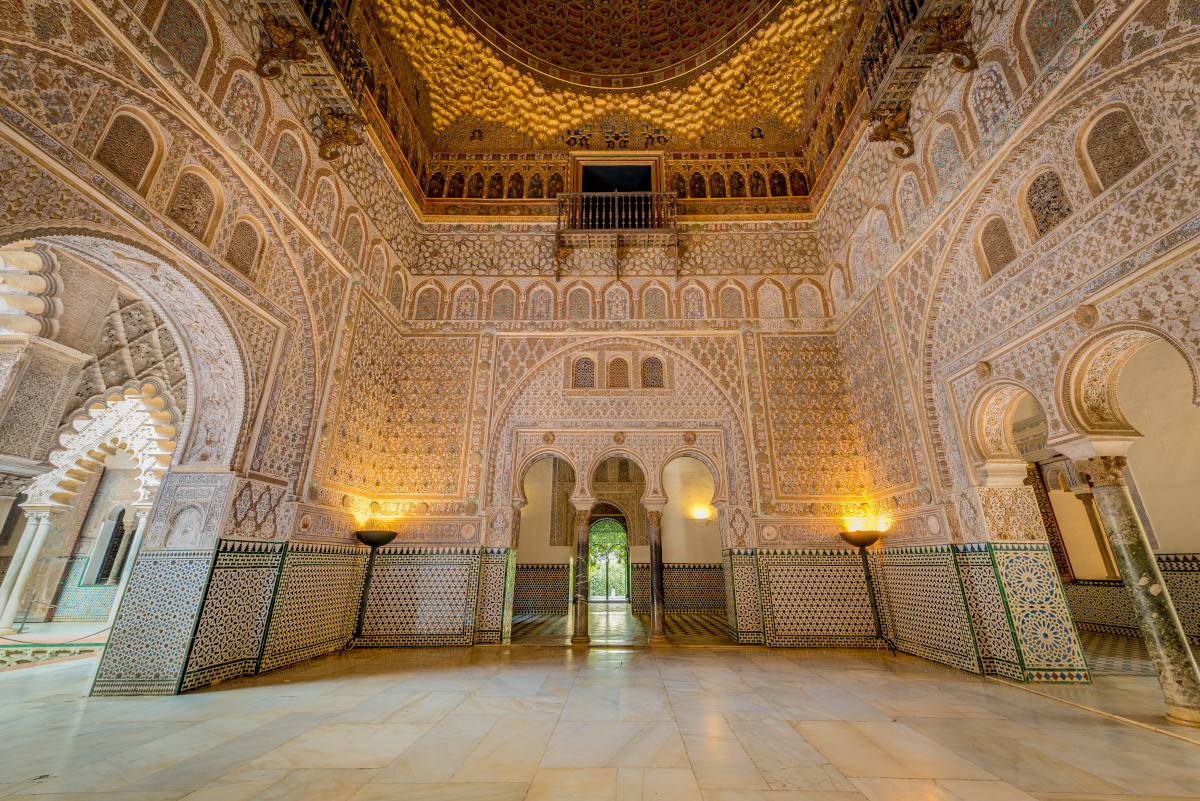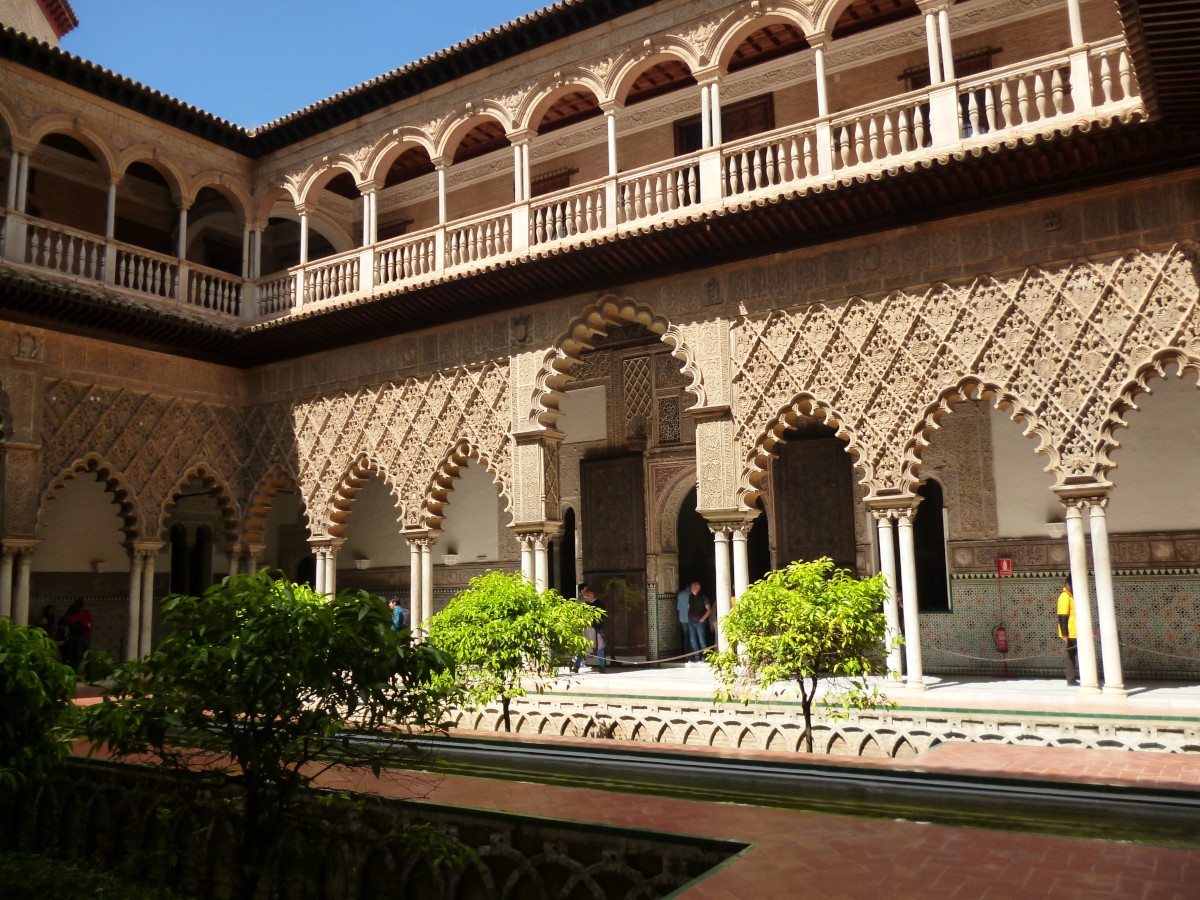The Alcazar is the heart of Moorish Seville, perhaps the most beautiful building in the city, although there’s strong competition. Its mix of Islamic, gothic and renaissance style is captivating and its beautiful gardens, again originally Islamic in style, are a haven of tranquillity in the very heart of the city. This post gives a little history, introduces some of the characters who have lived here and explains what to look out for when you visit.
building the alcazar

Seville became the capital of Moorish Spain in the 11th century and a strong defence was needed. So, the Moors began building this ‘royal palace’. By the 12th century, the Almohads, whose origins were Moroccan, were ruling here and they enhanced the palace further. The Caliph Abu Yaqub Yusef added the stucco courtyard, for example.
In the 13th century, Christians from northern Spain began to recapture Andalusia from the Moors, and in 1248 Seville was conquered by Ferdinand, King of Castille. He loved the beautiful Alcazar and decided to live there, even saying that he hoped to ‘die under its roof.’ Many Moors stayed on in the city, and so the fusing of Islamic and Christian traditions began and was reflected in the style of the palace as it evolved. Ferdinand’s son, Alfonso the Wise, made additions in the gothic style and enhanced the reputation of the court, surrounding himself with scholars from far and wide and gaining an international reputation in fields such as science, law and literature.
islamic influences



Pedro I became king in 1350 and he too furthered the mix of Iberian and Islamic styles. He was a Christian ruler, but friends with the Muslim Emir of Granada, from whom he borrowed carpenters and builders to work on extensions to the palace. Their Islamic influence is very evident in the ‘Patio de las Doncellas’ or ‘Courtyard of the Maidens’, which he added. The sunken garden is surrounded by arches, tiling and decorative plasterwork. Inscriptions on the palace walls underline this too, for ‘Don Pedro’ is referred to in Spanish as being King of Castille and Leon ‘by the grace of God’ and alongside this is wording in Arabic script proclaiming that ‘There is no conqueror but Allah.’
Arabic influences can be seen all over the Alcazar. The rooms are not separated by doors, but lead into one another through arches. There is fine decorative plasterwork, known as ‘yeseria’ and typical tiling with geometrical patterns in blue, green, ochre, black and white. The Spanish word for tiles is ‘azulejo’, from the Arabic ‘az-zulayj’, meaning ‘little stone.’ In the gardens, a geometric layout is very evident, along with typical water features like ponds, pools and fountains.
wealth from the new world
The catholic monarchs Ferdinand and Isabella, the first to rule over a united Spain, made Seville’s Alcazar one of their strongholds and presided there over the era of exploration to the New World, funding the journey made by Christopher Columbus in 1492, for example. They set up a ‘Casa de Contratacion’ here in the Alcazar to regulate this lucrative new trade and spent much of the vast wealth it brought them on enhancing the palace. Renaissance-style refurbishments they added included semi-circular arches, marble columns and a more European influence in the gardens.
look out for the highlights



The Maidens’ Courtyard is certainly a highlight. The sunken patio surrounds a rectangular pool and is surrounded by a highly decorated arched terrace leading back into various rooms. The sumptuous Ambassador’s Hall, one-time throne room of Pedro I is decorated in blue and gold, with a 12 pointed star decorating the central cupola. But really, the pleasure is in wandering from room to room, under archways and through the many, many beautiful rooms with their exotic names: the Dormitorio de los Reyes Moros (Bedroom of the Moorish kings) and the Cuarto del Almirante (Admiral’s Room).
In the gardens too, a saunter is the thing. The basic outline is geometric, but interrupted by a thousand delights: mini gardens with romantic names – Jardin de la Danza and Jardin de los Poetas, the gardens of dance and poetry respectively – pools and fountains, statues and surprises left across the centuries. You may happen upon the Gallery of Grotesques or the Lion’s Gloriette, or perhaps a surprise water jet which squirts up unexpectedly. Look out for the outdoor bath, set up for Maria de Padilla, the redoubtable wife of Pedro I who persuaded her husband not to allow a harem at the Alcazar, but to remain faithful to her.
It’s hard to overstate the beauty and charm of the Alaczar. A French visitor, one Eugène Poitou, writing in 1873, had a go at explaining its allure: ‘One is astonished, charmed, dazzled…. I do not think the Moors have ever been equalled in the art of internal decoration ….. a marvellous whole, so varied and so elegant are the forms.’ Allow plenty of time to explore and enjoy this intriguing mix of so many cultures. The word Alcazar itself is a pointer to the multiple layers within it: its origin is in the Moorish word Al-Kasr, itself derived from Caesar, so denoting a palace fit for an emperor.
Listen to the POdcast
Link for this podcast
Previous episode Introduction to Seville
Next episode The Cathedral, the Giralda and Santa Cruz
Last Updated on November 21, 2024 by Marian Jones






